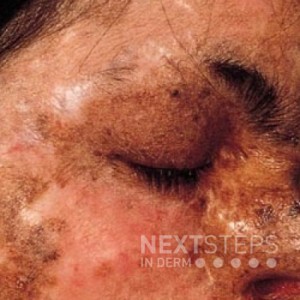
The correct answer is A. C is the most common subtype.
This is xeroderma pigmentosum. XPC is the most common subtype in the US. In this subtype there are no neurologic symptoms. In XPA, which is the most common subtype in Japan, there are often severe neurologic symptoms.
Xeroderma pigmentosum (XP) is a very rare skin disorder where a person is highly sensitive to sunlight, has premature skin aging and is prone to developing skin cancers.
Xeroderma pigmentosum is caused by cellular hypersensitivity to ultraviolet (UV) radiation, as a result of a defect in the DNA repair system. Xeroderma pigmentosum has also been called DeSanctis-Cacchione syndrome.
At least seven different gene abnormalities or complementation groups have been described in different families (XPA to XPG) resulting in varying disease severity.
- XPA and XPC are relatively common
- XPE is fairly rare
- XPG is severe
- XPF is mild
References: Lehmann AR, McGibbon D, Stefanini M. Xeroderma pigmentosum. Orphanet J Rare Dis. 2011 Nov 1;6:70. doi: 10.1186/1750-1172-6-70. Black JO. Xeroderma Pigmentosum. Head Neck Pathol. 2016 Jun;10(2):139-44. doi: 10.1007/s12105-016-0707-8. Epub 2016 Mar 14. PMID: 26975629; PMCID: PMC4838978.
